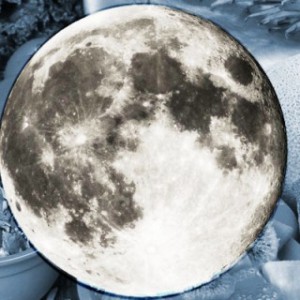by Melissa Melton
Now that we have a yard, Aaron and I have been reading everything we can get our hands on regarding organic gardening and how to turn our yard into something that produces nutritious stuff we can serve up on our dinner table.
We’ve been reading so many books, we have books piled on top of other books and some books have led to buying more books. In short, there’s a small organic gardening library growing over here, and we’re learning something new every day.
One book we have been reading — Lessons in Nature — a book about how to grow things organically in Texas mentioned that many farmers swear by planting according to moon cycles. The book is chock full of interesting stuff, but I’ll get to that one later.
The moon gardening thing was a new one on us (gardening is typically associated with the sun, not the moon, right?) so we pondered it for a second. I remember when I thought I had gone into labor with my second child, the doctor at the hospital’s head was spinning because so many women were coming in that night thinking the same thing, something the doc attributed to the full moon. I remember a nurse saying every full moon around that place was like that. Police have also attributed “the lunar effect” to causing more crime than other times of the month. Others say a connection between the moon and fertility, birth or any human or animal behavior (other than animals which are nocturnal by nature) is simply hogwash.
Still, we’re open-minded and willing to consider all options when it comes to making our garden grow using every possible tip and trick at our disposal. After looking into it, we decided to pick up a copy of Llewellyn’s 2014 Moon Sign Book: Conscious Living by the Cycles of the Moon because, well, it is a relatively cheap book and we wanted to see if there was any merit to it.
The book is laid out with a weekly almanac that gives dates and times for various gardening activities, including when (and what) to plant, cultivate, graft, trim and/or harvest based on the moon’s relation to where constellations are in the sky from the earth’s point of view (geocentric). Just flip to the date and it tells you what to do (complete with a section in the back that breaks it down by zones). Each page in the calendar section also has random, often interesting factoids about all manner of what-have-you — everything from tips for storing herbs to quick salad dressing recipes. There’s also a whole guide on when to plant pretty much anything and also a list of when to do other things by the moon’s cycles too for anyone interested.
Basically it’s a moon cycle buffet, book style, which aims to help any gardener get the most of out their harvests simply by observing where the moon is when one gardens.
Okay, pretty interesting concept…but does it freakin’ work?
Flipping through it, we came across a section that discussed the whole idea of gardening by the moon, which starts out by talking about how the approach is typically rejected outright, mostly by people who live in cities and have little contact with nature or its cycles. I have to admit, I’ve been a city dweller for a lot of my adult years, and I had never even heard of or considered this concept except maybe in passing.
Then book goes on to quote the work of Dr. Clark Timmins who has apparently done some pretty extensive modern day gardening/moon cycle research. This is what he found:
Examples from page 62 in Llewellyn’s 2014 Moon Sign Book:
- Beets: When sown with the moon in Scorpio, the germination rate was 71% as compared with 58% in Sagittarius.
- Carrots: When sown with the moon in Scorpio, the germination rate was 64% versus 47% in Sagittarius.
- Tomatoes: When sown with the moon in Cancer, the germination rate was 90% versus only 58% in Leo.
- Transplanting during a waxing Cancer moon saw 100% survival, versus transplanting during a waning Sagittarius moon which saw 0% survival.
- Weight and size of Cancer fruit were 45% bigger than Leo fruit.
In short, some of these numbers add up to a lot more food.
Experiments were reportedly controlled to eliminate variation in temperature, soil type, etc. and Timmins’ sowing wasn’t even done in regard to moon phases but just the moon’s position in the sky relative to the constellations, which the book claims were the phases considered, the study would have produced even better results.
There are entire websites out there dedicated to this long-held gardening practice as well. Obviously we’re just getting started here, so the judges are out on this one in our backyard, but when you’re a newbie just trying to grow something for the first time, it feels a little bit like being thrown out into the open ocean without arm floaties sometimes. We’ve lost whole groups of transplants for seemingly no reason. We’ve watched beloved veggies die before they ever were. It’s still all a learning process for us.
After reading through the book, we’ve decided we’re going to give this a try. After all, farmers have been doing it for hundreds of years. While we might hit the lunar jackpot, even if as some city dwellers suggest it’s all made up junk science, I guess we figure it can’t really hurt to give it a try either way, can it?
(Updates to come!)
This article was originally published at Ready Nutrition™ on August 17th, 2014








Have you heard of Rudolf Steiner and his biodynamic agriculture research? https://en.wikipedia.org/wiki/Rudolf_Steiner
He created all this 100 years ago. Google him…